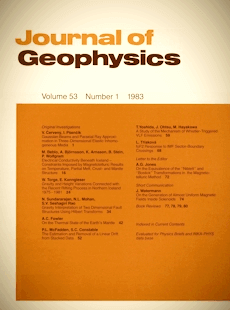Electrical conductivity beneath Iceland - constraints imposed by magnetotelluric results on temperature, partial melt, crust- and mantle structure
Article Sidebar

Vols. 1-18 (1924-1944), ISSN 0044-2801
Main Article Content
Abstract
Magnetotelluric results from 38 sites in North Iceland yield a detailed spatial distribution of conductivity versus depth. A high-conductivity layer, about 10 Ωm, marking the transition between crust and upper mantle is detected throughout the surveyed area, its depth increases from 10 km within the zones of present tectonic activity to 20–30 km at a 50–100 km distance from the rift axis. The high conductivity layer indicates some basaltic melt fraction at temperatures around 1,000°C. The calculated average crustal temperature gradients are 100–150°C/km at the rift axis and 50–70°C/km at about 100 km distance. Below this anomalous zone, down to 150 km depth, the conductivity decreases to 100 Ωm due to the ultrabasic chemical composition of the upper mantle and a possible decrease of melt content with increasing depth. The temperature gradient within the upper mantle cannot be more than a few °C/km. However, a highly conducting asthenosphere exists below 150 km depth. The following petrological model for Iceland is suggested: Diapiric updoming of the asthenosphere leads to partial fusion of parent ultra basic mantle material, resulting in segregation and upward migration of basaltic melt. Lower density, lower viscosity and higher mobility relative to the solid phase causes the melt to rise faster than the ultrabasic material. This melt fraction then forms the basaltic crust of Iceland which is thickening away from the ridge axis with increasing age.
 ARK: https://n2t.net/ark:/88439/y023054
ARK: https://n2t.net/ark:/88439/y023054
Permalink: https://geophysicsjournal.com/article/98
Article Details
References
Beblo, M., Bjornsson, A. (1979) Magnetotelluric investigation of the lower crust and upper mantle beneath Iceland. J Geophys. 45:1-16
Beblo, M., Bjornsson, A. (1980) A model of electrical resistivity beneath NE-Iceland, correlation with temperature. J. Geophys. 47:184-190
Bjornsson, A. (1976) Electrical resistivity of layer 3 in the Icelandic crust. Soc. Sci. Islandica, Greinar 5:7-23
Bottinga, Y., Allegre, C. (1976) Geophysical, petrological and geochemical models of the oceanic lithosphere. Tectonophysics 32:9-59
Bottinga, Y., Steinmetz, L. (1979) A geophysical, geochemical, petrological model of the sub-marine lithosphere. Tectonophysics 55:311-347
Bram, K. (1980) New heat flow observations on the Reykjanes ridge. J. Geophys. 47:86-90
Einarsson, P. (1978) S-wave shadows in the Krafla caldera in NE-Iceland, evidence for a magma chamber in the crust. Bull. Volcanol. 41:1-9
Filloux, J.H. (1981) Magnetotelluric exploration of the North Pacific: Progress report and preliminary soundings near a spreading ridge. Phys. Earth Planet. Int. 25:187-195
Filloux, J .H. (1982) Electrical conductivity structure of the seafloor beneath the North Pacific. Proceedings Symp. on Electromagn. in the Transition zone between ocean and continent. Earthquake
Research Institute. The University of Tokyo
Gebrande, H., Miller, H., Einarsson, P. (1980) Seismic structure of Iceland along the RRISP-profile. J. Geophys. 47:239-249
Haak, V. (1978) Interpretations-Verfahren fur die Magnetotellurik unter besonderer Berucksichtigung lateral variierender elektrischer Leitfahigkeit im Erdinnern und eines raumlich inhomogenen induzierenden Magnetfeldes. Munich: Bayerische Akademie der Wissenschaften
Haak, V. (1980) Relations between electrical conductivity and petrological parameters of the crust and upper mantle. Geophysical Surveys 4:57-69
Haak, V., Damaske, D. (1980) Erste Ergebnisse aus den langperiodischen Magnetotellurik-Messungen in Island. Prot. Erdmagn. Tiefenforschung. Berlin-Lichtenrade, 61-67
Hermance, J.F. (1981) Crustal genesis in Iceland: Geophysical constraints on crustal thickening with age. Geophys. Res. Lett. 8:203-206
Hermance, J.F., Grillot, L.R. (1970) Correlation ofmagnetotelluric, seismic and temperature data from southwest Iceland. J. Geophys. Res. 75:6582-6591
Hersir, G.P., Bjornsson, A., Pedersen, L.B. (1983) Magnetotelluric survey across the active spreading zone on South west Iceland. J. Volcanol. Geotherm. Res. (In press)
Kemmerle, K. (1977) Magnetotellurik am Alpen-Nordrand mit Diskussion der lokalen Effekte und Darstellung einer Einzeleffekt-Auswertung. University of Munich: Diss. Fak. Geowiss.
Palmason, G., Arnorsson, S., Fridleifsson, I.B., Kristmannsdottir, H., Saemundsson, K., Stefansson, V., Steingrunsson, B., Tomasson, J ., Kristjansson, L. (1979) The Iceland crust: Evidence from
drillhole data on structure and processes. In: Talwani, M., Harrison, C.G., Hayes, D.E. (Eds.) Deep drilling results in the Atlantic Ocean. Ocean crust. Am. Geophys. Union. Maurice Ewing Series 2:43-65
Reddy, J.K., Rankin, D., Phillips, R.J. (1977) 3-dimensional models in magnetotelluric and magnetic variational sounding. Geophys. J.R. Astron. Soc. 51:313-325
Ringwood, A.E. (1969) Composition and evolution of the upper mantle. In: Hart, P.J. (Ed.) The Earth's crust and upper Mantle, pp. 1-17. Am. geophys. Union, Monogr. 13
Sanford, A., Einarsson, P. (1982) Magma chambers in rifts. In: G. Palmason (Ed.) Continental and oceanic rifts. Am. Geophys. Union. Geodynamic Series 8:147-168
Schmucker, U. (1974) Erdmagnetische Tiefensondierung mit langperiodischen Variationen. Prot. Erdmagn. Tiefensondierung Grafrath, 313-342, Milnchen
Shankland, T.J., Waff, H.S. (1977) Partial melting and electrical conductivity anomalies in the upper mantle. J. Geophys. Res. 82:5409-5417
Stein, B. (1982) Modellrechnungen zum Kusten-Effekt in der Magnetotellurik; Anwendung auf die Messungen in Nord-Island (1977 and 1980) Dipl.-Arbeit, Univ. Milnchen
Thayer, R.E., Bjornsson, A., Alvarez, L., Hermance, J.F. (1981) Magma genesis and crustal spreading in the northern neovolcanic zone of Iceland: telluric-magnetotelluric constraints. Geophys. J.R.
Astron. Soc. 65:423-442
Waff, H.S. (1974) Theoretical considerations of electrical conductivity in a partially molten mantle and implications for geothermometry. J. Geopliys. Res. 79:4003-4010
Wolfgram, P. (1980) Zeitvariationen des Erdmagnetfeldes, gemessen auf einem Profil durch Nordost-Island, 1977. Dipl.-Arbeit, University of Munich
Zverev, S.M., Litvinenko, I.V., Palmason, G., Yaroshevskaya, G.A., Osokin, N.N., Akhmetjev, M.A. (1980) A seismic study of the rift zone in the northern Iceland. J. Geophys. 47:191-201











